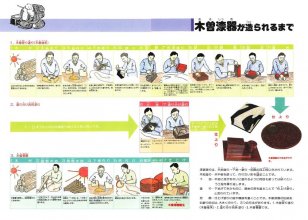| 特別な漆器の製造工程とは |
|
|
Lacquer is the plant juice obtained from so-called lacquer plants. (the juice extracted from the trees, similar to natural rubber extraction). This is used as a dye and for other purposes, e. g. as an adhesive. It is a plant that is peculiar to East Asia. Paint was first used as a dye in China 4000 years ago. In Japan, since the Jomon period, many pottery vessels have been found in the production of which varnish has been used. The amount of paint consumed in Japan is 500 tons per year. More than 95% of these are imported from China. The amount of paint produced domestically in Japan is low, but the quality is particularly high. The main manufacturing areas are the prefectures of Aomori, Iwate, Akita, Ishikawa, Nagano, Gifu, Fukui, Niigata, Chiba and Ibaraki. Raising a lacquer tree is a difficult task. Only the cultivation area adapted paint trees can be raised. For example, it would be impossible to raise paint trees from a warm country in Japan, and vice versa, it would also be impos-sible to raise a lacquer tree from Japan in a warm country. The advantage of this "varnish" is that it is extremely resistant to acids and alkalis as well as to heat and cold. The current resistance is high; also against ultraviolet and infrared radiation the resistance is higher than other synthetic dyes. Varnish is a dye that is also excellent as an adhesive; a better dye has not yet been found. Production steps of the lacquer:
1. On a varnish tree -the place where the varnish sap is found- has to be removed. Then an "iron" (Kawahagi) is used to create a piece of bark
peeled off.
2. A wrench sickle is used to remove horizontal, approx. 8-10 crevices into the in the peeling area. The distance between the cracks should be about
1 cm.
3. With the small blade on the key-sickle the cracks are deepened and extended. After a short time, the varnish juice seeps out of the extended
scribing.
4. The leaked juice is filled with a spatula- and collected in a jar. 5. Impurities are removed from the varnish juice. If this is done with a centrifuge, cotton is mixed with the lacquer juice. In ancient times, it
was screened by hand using Japanese paper.
6. The filtered paint juice contains excess water.
|
|

